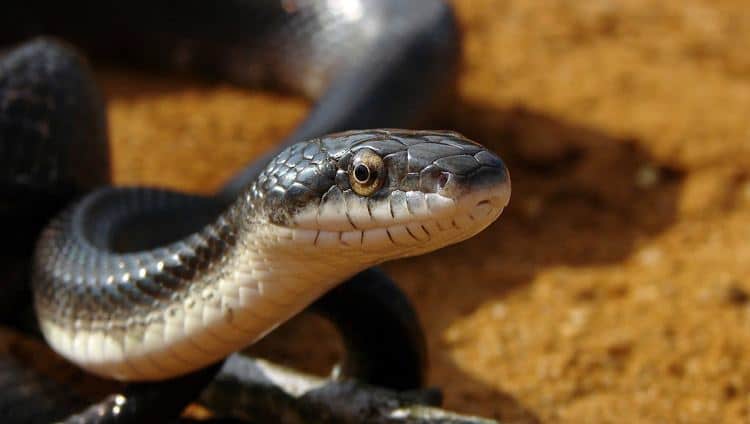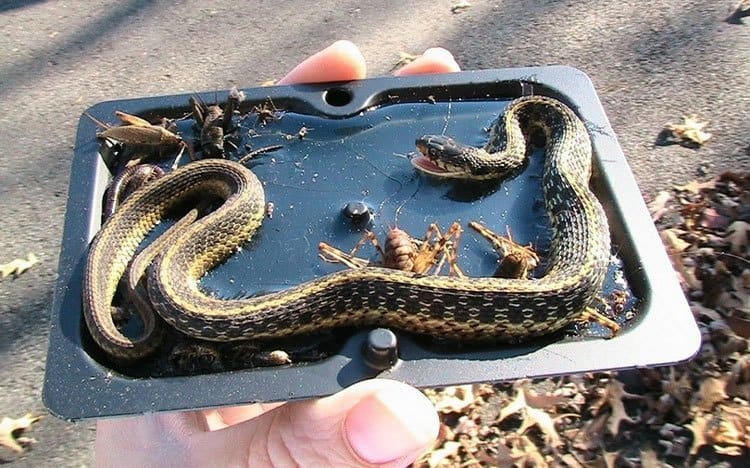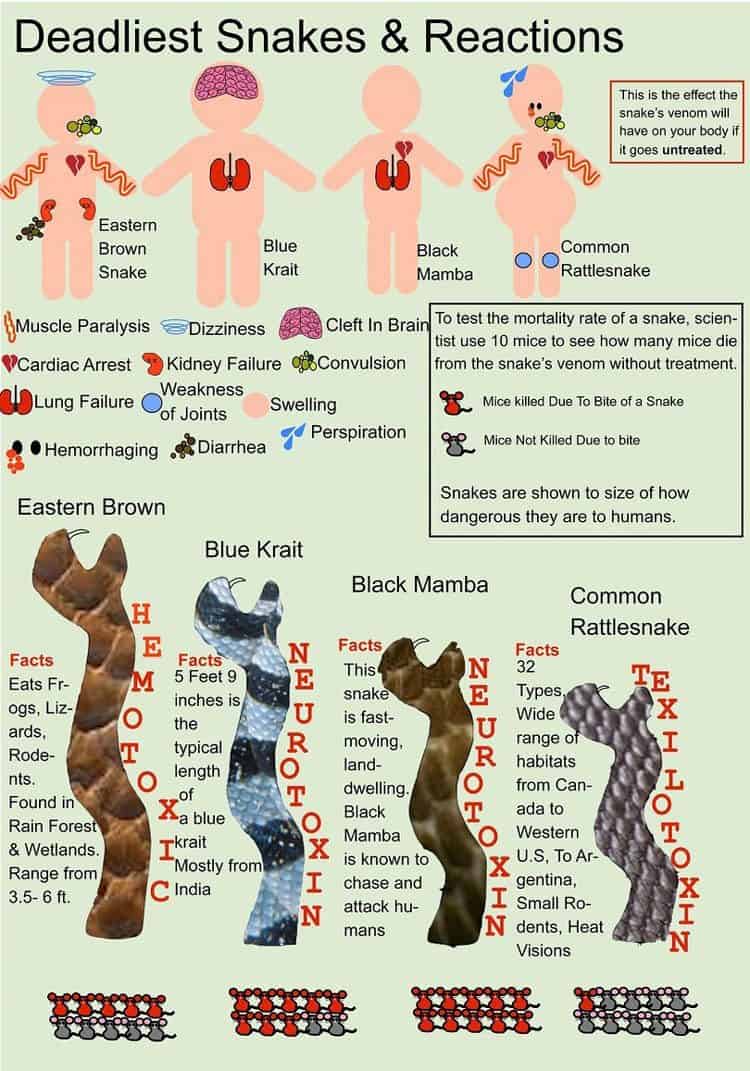You’ll never know when a snake will show up; it could surprise you hanging around in your basement or garden. Worse scenarios include a snake swallowing your beloved poultry animals in your chicken coop.
However, it would be inhumane if you kill snakes right away especially if it doesn’t pose a threat. After all, it’s just like any other animals – not capable of rational thinking (though they are smarter than others).
With a better sense of thinking, you hold the responsibility of achieving a win-win situation for you and the snake in case one shows up. The most humane way of handling a snake situation is trapping and releasing it somewhere.
In this article, I’ll show you how to make a snake trap?, as well as provide all relevant information related to it.
Identifying Different Species
In case you’ve spotted a snake(s) nearby and lost it, it is recommended to make a trap immediately. But before that, you must first identify the snake if you can. It’s important to recognize the species you intend to trap so you know what you’re dealing.
Knowing what type the snake you saw allows you to assess the right trap, as well as decide how cautiously you need to handle the snake once it has been captured.
Note: If you have pets or kids that you think is in grave danger due to possibly getting bitten, get your members out of your house immediately and call animal control right away and have them catch the snake for you.
Venomous snakes

Have a copper look and black stripes.Warning signs that the snake is venomous
- Have triangular heads bigger than their necks
- Have thick bodies as primary characteristic
- Have vertical pupils
- Makes a rattle sound
- Have a brightly-colored coral pattern but a very rare species
- When you see one in a body of water.
- Non-venomous snakes

You can tell if the snake is non-venomous when:Don’t be alarmed, though; the snakes which you encounter in your basement or backyard are mostly harmless.
It may be frightening to find a 5-foot snake in your basement, but they usually pose no harm to your pets or fellow humans. Most of them just wander, got lost, and unfortunately came by your home.
- They have round pupils (venomous ones have vertical)
- They do not rattle (unlike rattlesnakes)
- They don’t attack (but it doesn’t mean it’s safe enough to take pictures with it)
Note: Non-venomous snakes may not have lethal bites, but they are still dangerous as they can wrap around a prey’s body and squeeze it to death.
Ways On How To Make A Snake Trap
Using A Glue Trap
Where to buy Humane and efficient at the same time, setting a glue trap is a safe way to catch snakes. Matter of fact, glue traps is the most common way to catch snakes.

Glue snake traps are not rare in home and garden supply stores. Ensure that you’ll buy something that’s large enough to contain the snake. There are also a lot of brands to choose from, but basically, they all work the same.
However, some have added features like being reusable. Despite that impressive feature, it’s still good to buy a single-use trap to ensure efficiency.
How to use
These traps come in both large and small sizes; these are typically boxes that you will put in a spot near the snake itself. If you can’t find the snake, put the glue trap in the place where you last see it. At least you’re able to set the trap where the snake is still possibly nearby.
How it works
Glue traps are usually made with the bait already installed inside, so you don’t need to worry about that. When the snake is attracted to get the bait, it will crawl inside the trap and will get stuck due to the glue on the trap’s floor, hence trapped.
What to do next
Observe whether the snake is already glued or not. Once glued, you can now transfer the snake somewhere else. You can either call the animal control hotline or drive your way to a remote place suitable to release the snake to safety.
How to release the snake
Open the trap and simply pour oil over the snake until it gets loose and let it glide away from the trap. You should also be cautious enough not to touch or harm or the snake so it can’t do the same thing to you.
Depending on what you bought, there are glue traps that don’t need to be opened when letting go of the snake; they are specially designed for a safe snake disposal. You might want to check this feature out.
Simple Bottle Trap
Grab the following:If you have a small pet snake that’s become elusive enough to escape without you noticing it, then this trap is recommended for you. It is a basic homemade trap made of a plastic bottle.
Be careful though, there’s no hundred percent assurance you’ll catch the snake you’re looking for because there’s also a chance you’ll capture a different one.

- Bait – a frozen mice which you use to feed your pet snake when it still hasn’t escaped
- Tool – just a pair of scissors
- Trap – A plastic bottle (1.5L coke will do) that is washed, rinsed, and dried
How to Set Up
- Ensure the container is thoroughly washed and dried; no other smell must come out from the bottle.
- Cut a small hole using your scissors. The diameter must be enough for your snake to come in.
- Place the bait inside the bottle.
- Set the trap where you believe your snake hides.
- Wait until the snake enters the bottle and wait again for it to eat the bait.
How it works?
All snakes share the same characteristic when it comes to eating – they do NOT chew. Instead, they swallow. Once your ‘presumptive hungry’ snake got in the hole with a diameter enough for it to pass through and ate the mice, it won’t be able to come out.
Since it swallowed the whole mice, you can expect its body to be rounder and bigger. Thus, it will get stuck and can’t get out of the bottle.
Also, it is assumed that the snake will sit tight for the meantime to start its digestion process. When that time comes, you can get the bottle and place it in its proper place where it should be.
Minnow Trap
Grab the following:Minnow Trap is also known for the term “funnel door wire cage snake trap”; the concept of this trap is similar to the simple bottle trap only that you can catch larger snakes with it.
This trap is also suitable to be placed in the sun in a place where you feel like the snake is hanging around.

- Wire cutters
- Wire
- Anything that keeps everything in place
How to set up:
- Using your wire, make two identical cylinder cones out of it. The diameter must be about 15cm – 20cm depending on the size of the snake you want to capture.
- Using the same wire, make a funnel out of the two cylinders.
- The funnel part is important; make sure the hole is small enough for the snake to pass through and big enough to make it stuck when it has something in its belly.
- Put some eggs, more or less three pieces, as baits inside the cylinder.
- If you want to convince the snake, you can put live baits such as big insects or mice. The smell and movement of these animals attract the snake.
- The third step is to put the two identical cylinders together and sealing them with wires.
- Now you have a minnow trap with funnel entries on both sides.
How it works?
Just like the bottle trap, the snake will be lured inside because of the baits (eggs). When it swallows the whole eggs, it won’t be slim enough to get out. Now is your chance to relocate the snake.
The problem now is releasing the snake. The wires holding the identical cylinder must not be permanently sealed; locked enough to prevent the snake from escaping but not too sealed for you to open it quickly.
Notes
If you’re not comfortable with making one, there are minnow traps available in local stores. They are ready for use and can be utilized again for multiple times.
You should check your trap regularly because the snake might be able to come out if it has already digested the food inside it.
Wooden Box Snake Trap

This trap is a little complicated to make so I suggest looking for it in a local specialized shop. This trap can be used if you’ve spotted a wild snake in your house which means you need a larger ‘weapon’ against it. The wooden box can be placed near the den of your identified snake.
How it works
The main idea is to put the trap just at the entrance of the snake hole. When the animal tries to leave its hole, it can be lured directly at the box.
Once the snake enters, it triggers the box to close its cover, hence trapped. Now you can carry the box and release the snake someplace else.
When not confident enough to make a homemade snake trap, you can always purchase in a local store. Since now you know how to make a snake trap, it’s time to wait until the snake gets captured. Continue reading to know what to after you caught the snake.
What To Do After You Trapped The Snake?
First Rule: Don’t Touch
The primary rule you need to keep in mind after being able to capture the snake is ‘never dare touch to touch it.’
This rule is highly important especially if you have no idea what type of snake you have captured. Unless you know what you’re dealing with, then you can do appropriate actions to it. Otherwise, it would be wise to let it sit in your trap for the meantime.
A wild snake, in particular, does NOT like being touched. When you try to touch it, expect it to become violent, and it will try to bite you.
Aside from touching it, you should also avoid poking or shaking it. Also, do not allow your kids or pets to come near the snake. Snakes can only infuriate because it treats you as a threat. Remember, trapping a possibly deadly animal is not child’s play.
Second Rule: Relocate
Carefully lift the trap and put it in your car compartment. It’s not advisable to drive with the snake trap right beside you in the passenger seat. Be safer than necessary when handling these unfriendly creatures.
Now drive someplace that is at least 2 miles away from your home or where you found it. Snakes are smart enough to crawl their way back to their former territory so you must choose a place that is at least this far; even better if you could go further.
It is also important to pick a place where there are no neighborhoods nearby; you wouldn’t want the snake to disturb another home. Putting in a populated area may harm the people in it. So make sure you release it in a remote area.
What if I get bitten? Snakebite first aid.

Bites can be life-threatening. Snakes produce venom that could stop your heart; something you apparently don’t want to experience. Here are the steps to do when you got bitten.
- Call 911 right away!
- If the snake escaped, try to remember its shape and color so the medical personnel can better evaluate the right anti-venom for you. Remember, not all snake bites require the same treatment.
- While waiting for the medical staff stay calm and keep the distance away from the snake because it may strike again.
- Position yourself in a way that the bitten part is below the heart level. For instance, if you get bitten in the legs, stand and do NOT lie down. By that, the venom will have a hard time reaching up for your heart.
Don’ts When You Get Bitten
These are the attempts that you should NOT do in case a snake bites you, regardless if you know it’s venomous or not. Being safe than sorry is better.
- Attempting to remove the venom
- Applying ice of using a tourniquet
- Capturing the snake (Instead, try to remember what it looks like)
- Drinking alcohol or caffeine (they could speed the rate of venom circulation in your body)
Releasing the snake
This part is a little uncertain because you never know how the snake will act when you open its trap. Be prepared because some snakes will turn against you; their nature perhaps?
However, there are also some snakes that are happy enough to be released and will just slither and get lost in the grass.
What to wear
Wear long pants (multiple layers if you can) and thick gloves in case the snake will initiate a quick turn and strike.
Freeing the snake
The trap only serves as a temporary isolation for you to transport it where it should belong. Depending on the type of trap you used, there are different ways of freeing your captured snake.
- When using glue trap, pouring vegetable oil into the snake’s body will eventually slide away from the glue.
- When using a minnow trap or a funnel wire, just retract the funnel wire to make an opening and let the snake decide to when to get out. Note: Always wear gloves because you’ll be closer to the snake this time.
- When using a wooden box, put the box in the field and carefully open the lid. Do not force the snake to come out. Also, do not poke it or do anything to it. It will find its way out.
Be careful enough when you open the trap because some snakes can jump to its prey. It may look funny, but the safest thing to do is to run as fast as you can after lifting the lids. Get back to your car and drive home safely. However, this means leaving your trap behind.
If you value your trap and want to use it again for future use, you are always free to wait until the snake comes out and goes out of view.
By then, you can get the trap and head back home. Always be careful, though; the snake may come out, but you can never be so sure whether it just hides and waits to revenge or not.
Conclusion
There you have it. You now have relevant information on how to make a snake trap. Not only that; you also get to know all essential facts and crucial information related to this topic. The next time you spot a snake in your premises, you already know what to do!

